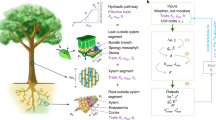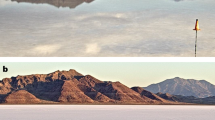Abstract
PROFESSOR LEVITT1 argues that the chief resistance to water transfer through the soil-plant-atmosphere continuum is in the liquid path through the plant, and not in the gaseous path from plant to atmosphere as concluded by Gradmann2 and van den Honert3. The basis of his argument is that while water potentials are appropriate to transfer of the liquid through the plant, vapour pressures should be used in the Ohm's law analogue of the flow from plant to atmosphere, because gas diffuses in response to a vapour pressure gradient.
This is a preview of subscription content, access via your institution
Access options
Subscribe to this journal
Receive 51 print issues and online access
$199.00 per year
only $3.90 per issue
Buy this article
- Purchase on SpringerLink
- Instant access to full article PDF
Prices may be subject to local taxes which are calculated during checkout
Similar content being viewed by others
References
Levitt, J., Nature, 212, 527 (1966).
Gradmann, H., Jahrb. Wiss. Bot., 69, 1 (1928).
van den Honert, T. H., Disc. Farad. Soc., 3, 146 (1948).
Philip, J. R., Ann. Rev. Plant Physiol., 17, 245 (1966).
Author information
Authors and Affiliations
Rights and permissions
About this article
Cite this article
PECK, A. Resistance to Water Transport in Plants—a Misconception?. Nature 212, 1585 (1966). https://doi.org/10.1038/2121585a0
Received:
Published:
Issue date:
DOI: https://doi.org/10.1038/2121585a0



